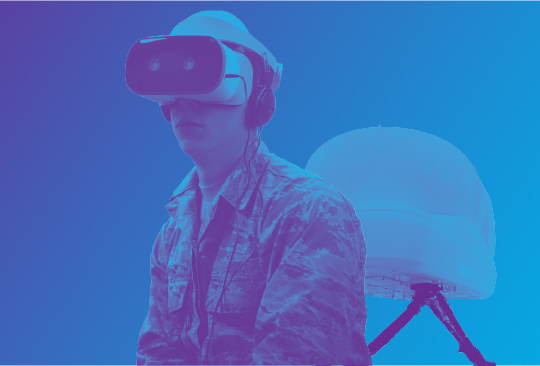Solo™ Comms Solution for Military VR Flight Trainers
Customer
Military flight training schoolApplication
This customer facility features multiple, intermediate-level PC-based virtual reality (VR) workstations for ab-initio flight training. While the VR trainers featured basic communications capabilities for students, the instructors lacked the ability to communicate with them from within the simulation. They needed a new way to integrate computer-based communications without disrupting their existing architecture.

Challenges
&
Solutions
The challenge requirements are listed in blue; ASTi's applicable components are

Fill the comms gap between instructors and students
The training program setup and configuration was complete, and a number of VR training systems were already in use at the customer facility. One obvious issue, however, was the instructors’ inability to conveniently interact with trainees without interrupting their training missions. So they tapped ASTi to solve their problem.
But how does one add distributed communication capabilities to an existing facility with zero changes to its network topology or infrastructure? Especially when the customer facility uses one PC per VR trainer with no centralized server rack, nor does it have the space (or desire) to add one? ASTi's answer is called Solo™.
Solo is an app that provides a complete virtual comms and radio environment to Windows PCs. Simply installing Solo on a PC-based trainer gives it the same communications capabilities offered by ASTi's other industry-leading products like Voisus and Telestra. Unlike those solutions, however, Solo features a peer-to-peer network implementation versus a central, server-centric approach. Installing Solo on the trainer PCs, as well as the instructors' computers or tablets, provides a reconfigurable communications environment to fit the program's current and future training needs.
Make it flexible
Solo boasts a complete set of features allowing administrators to configure and redesign its comms topology at will. Comm plans and Roles (like those used in ASTi's Voisus product) allow administrators to build multiple virtual radios of all types and assign one or more of them to instructors, students, observers, administrators, etc.
This allows multiple modes of communication during training missions without having to change radio settings inside the simulation:
- Instructor to single student
- Instructor to multiple students
- Multiple instructors to multiple students
- Instructor-only comms back channel
- Role players to one or more students
- Maintenance intercom when simulation is halted
To offer even more flexibility, instructors can use Solo over WiFi on their Windows tablets as they monitor and connect with multiple students as needed during training missions.
Maintain the realism of the simulation
Without computer-based communications, the only way a trainee can hear an instructor's voice is for the instructor to speak at a volume exceeding the student's earphones or for the student to remove or relocate the VR headset away from their ear(s). The first choice is highly disruptive in a facility where multiple devices are positioned close to each other. The second extinguishes any immersion the student experiences during training. And both violate the realism that the simulation is intended to provide!
Solo delivers instructor-to-trainee communications directly through the students' headsets with no further accommodation. Since Solo provides a fully simulated radio environment, anything that uses a virtual radio in the simulation can also be heard. This could be air traffic control (ATC) instruction, automatic terminal information service (ATIS) messages, aircraft intercoms, or even lead-to-wing comms during tactical formation flying.
Make it a software-only solution
With each VR device using one Windows PC for all aspects of the training environment, that single computer already has a lot to do. It has to run the simulation, generate the graphics, create all the sounds, and handle all the networking. Any addition to the devices' software baseline cannot compromise its performance, or else the training experience will suffer.
Solo's lightweight installation preserves processing power so the existing systems can continue to operate effectively with zero performance degradation.
Further, Solo integrates with existing Windows subsystems to work with the trainers pre-installed peripherals. USB flight sticks provide press-to-talk keying for virtual radios while the earphones on the VR headsets provide realistic, in-the-ear voice communications. No special hardware is required.
Keep it clean
As with the majority of military training programs, public WAN access needs to be restricted since Internet- and cloud-based solutions are often difficult to secure. As new and more advanced threats arise, maintaining the security of these setups is a continuous burden on program personnel. As Solo is a single-PC application, it requires zero connectivity outside the local-area network, and never has to "phone home" to register or renew a service subscription.